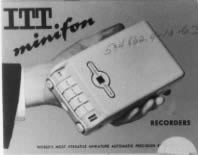A major shift came after 1945, when wire and tape recorders became available. While they were not usually advertised for such purposes, many users apparently used them to make surveillance recordings. By now, the legality and ethics of making secret recordings was in question. The first discussions in the courts of whether or not sound recordings could be admitted as evidence began to appear at about this time. The practice became a part of the general consciousness, as the making of secret recordings began to be a common element in the plots of novels and movies, but the size of the machines and their general lack of portability probably made their actual use much less common than that.

Minifon “pocket” recorder
It was not until the introduction of the transistor recorder in the early 1950s that secret recording really took off. Shortly after “pocket” size tape and wire recorders appeared, several companies actually began promoting their use to make secret recordings. The Minifon, a West German product, was the best-known of these in the U.S. Cold War paranoia was growing, and so too was the public’s fear/fascination with spies and their gear, including miniature recorders .